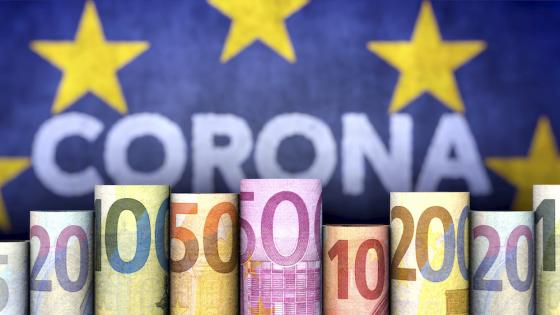The fight against the Covid pandemic in the EU requires that all national governments can finance the required spending, hence that they are not constrained on the markets. To this aim, the ECB’s announcement on 18 March of a Pandemic Emergency Purchase Programme (PEPP) goes a long way. In a war, a government is usually backstopped by its central bank. Despite announced flexibility, though, the ECB may find it difficult to carry out potentially largely asymmetric interventions without an explicit joint fiscal backing.
It is still too early to know whether this pandemic will develop into a fully symmetric or somewhat asymmetric shock, where some member states are more hardly hit than others. What is sure, though, is that the Member states are unequal when it comes to borrowing large amounts on the markets. Hence the ability of financial support to adapt to the need of each country will be key. It is definitely in the interest of each Member state that a hardly hit country takes the necessary measures to control the pandemic. And from the perspective of those deeply hit countries, European solidarity will be key during this dark period and afterwards. Failure to cooperate in this crisis would send a very negative signal, potentially fatal to the European endeavour.
Tackling these issues requires a combination of fiscal and monetary actions. Given the time constraint, the solution to this coordination problem has to be found within a framework initially designed to protect monetary policy from fiscal policy: While a Eurobond would be appropriate, it is unlikely that an urgent introduction could be made. We therefore conclude with a proposal for a Covid Credit Line (CCL) of the European Stability Mechanism (ESM).
State of play: An enhanced, powerful response whose scope is however limited
Over the last decade, we have been concerned by the lack of a significant fiscal capacity to react to shocks at the level of the euro area. The reaction to the Covid crisis reflects this persistent flaw. So far, national governments and the ECB have been at the forefront while the other European institutions have remained well behind. The risk is that the euro area will lag behind the US and the UK in its fiscal response to the pandemic-induced economic crisis, with adverse social and economic implications.
On 13 March the Commission proposed to allocate to the relief effort €8 billion of unspent past Structural Funds credits and €28 billion from yet unallocated funds (total 0.25% of EU GDP). This action amounts to a sectoral reallocation of structural funds but not to a mutualisation or a reallocation across member states. On 16 March the Eurogroup announced agreement on (a) the overall economic response to the outbreak of the Coronavirus; (b) the exclusion of temporary fiscal measures taken in response to the Covid crisis when assessing compliance with the fiscal rules; and (c) the full use of the general SGP flexibility clause for all member states.1
On 18 March the ECB announced the launch of the PEPP, which complemented its previous week announcements of a new targeted longer-term refinancing operations (TLTRO), a new 120 billion tranche of asset purchases and temporary capital and operational relief for banks. The overall envelope for PEPP, €750 billion or more than 6% of GDP, is already substantial can be increased and its composition can be adjusted “by as much as necessary and for as long as needed”.
We regard the ECB initiatives as very significant and positive, which offer the possibility of responding flexibly to tensions on the sovereign bond market, while providing a backstop to the member states’ immediate relief effort.
The main problem with these initiatives is that the burden is once again on the monetary policy side. While this is perhaps inevitable in emergency and it has been the case also in other jurisdictions, we believe that, in a monetary union in particular, a large stimulus package needs to be more balanced on the fiscal side to be legitimate.
A joint Euro Relief Bond
Proposals have been made for embarking on a coordinated relief effort financed by joint debt issuance, effectively mutualising the response to the crisis. Member states would pledge tax revenues to the fund, allowing it to borrow on the market (with joint and several liability) and to finance relief actions throughout the EU/euro area. Expenditures would be allocated according to the severity of the health crisis and the need for relief.
There is much to say in favour of such an approach from the economic and political standpoints. However, a scheme of this sort faces two difficulties:
- There is no ready-to-use vehicle for joint debt issuance by the euro-area members. The EU budget cannot go into debt beyond Treaty-allowed financial assistance programmes. There is no euro-area budget; and the ESM is not a budgetary institution, so it can only lend to individual member states. Joint borrowing would require allocating tax revenues to repaying the debt, but no European institution has taxing power;
- Member states still have different strategies to cope with the crisis. This reduces the already fairly limited inclination towards joint solutions.
These obstacles can be overcome. A solution of this sort may eventually emerge as the first-best response to the emergency. But we fear its time has not yet come.
A dedicated ESM credit line: The Covid Credit Line
A possible scheme would be that a series of member states – ideally all of them in order to avoid any sort of stigma – apply to the Enhanced Conditions Credit Line of the ESM. This would give them access to ESM loans and open the way to an activation of the ECB’s Outright Monetary Transactions scheme, thereby further strengthening the ECB’s ability to control bond yield spreads and avoid self-fulfilling debt crises.
The ECCL is however a specific instrument intended to address country-specific market access risks. It can lend only for one year, with possible extensions up to another year.2 A better alternative would be for the ESM to create a new, dedicated Covid Credit Line with a long duration, access conditions and ex post conditionality.3 It should grant to all member states long-term credit lines dedicated to the financing of the Covid relief effort. Allocation across member states should be proportionate to the severity of the public health and economic challenges encountered. Conditionality should be minimal and consist in member states committing to be transparent in the use of the Covid Credit Line and not to introduce new discretionary spending or tax reduction measures that are not Covid-related as well as to wind down the Covid relief effort once the crisis is over. The duration of these credit lines should be very long because member states will emerge from the Covid crisis severely weakened and will not be in a position to repay soon. And the alternative of replacing ESM credit lines with newly issued domestic debt would frustrate the exercise. Consistently, the new bonds issued by the ESM should be of very long maturity, though at maturities that have a market.
This option would represent a concrete improvement in comparison to the current situation. The ESM has currently a €410 billion lending capacity (3.4% of euro area GDP), which can be increased by the Board of Governors. It would still involve little coordination and solidarity among member states, as each of them would remain sole responsible for its debt vis-à-vis the ESM. But a Covid Credit Line would help sustain the members’ effort, it would help make the corresponding borrowing cost independent of individual fiscal situations. Rising the volume of European (ESM) bonds would also be stabilising for the financial sector and would broaden the scope for ECB action.
Endnotes
1 This clause refers to “unusual events outside de control of government”.
2 “A PCCL and an ECCL credit line can be drawn via a loan or a primary market purchase. Both types of credit line shall have an initial availability period of one year and shall be renewable twice, each time for six months”. (ESM Guidelines, Art. 2.1)
3 Art. 19 of the ESM Treaty makes it possible for the Board of Directors to create new financial assistance instruments. Alternatively, the guidelines of the ECCL could be adjusted to fit for the purpose.















